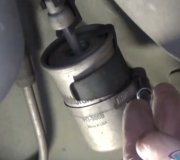Friday, February 14th, 2014 AT 11:52 PM
I have an automatic 2005 Suzuki Forenza with an estimated 120,000 miles. My car has had no problems since I got it until today. I drove it twice to the store and back, no problems. The third and last time I drove it I was on my way to the grocery store when my car just stopped running. My gas gauge said I had fuel so I know that's not the case. When I try to start it nothing happens, I can however hear the starter and the fuel pump. Along with the buzzers and alarms. But that's about it.


